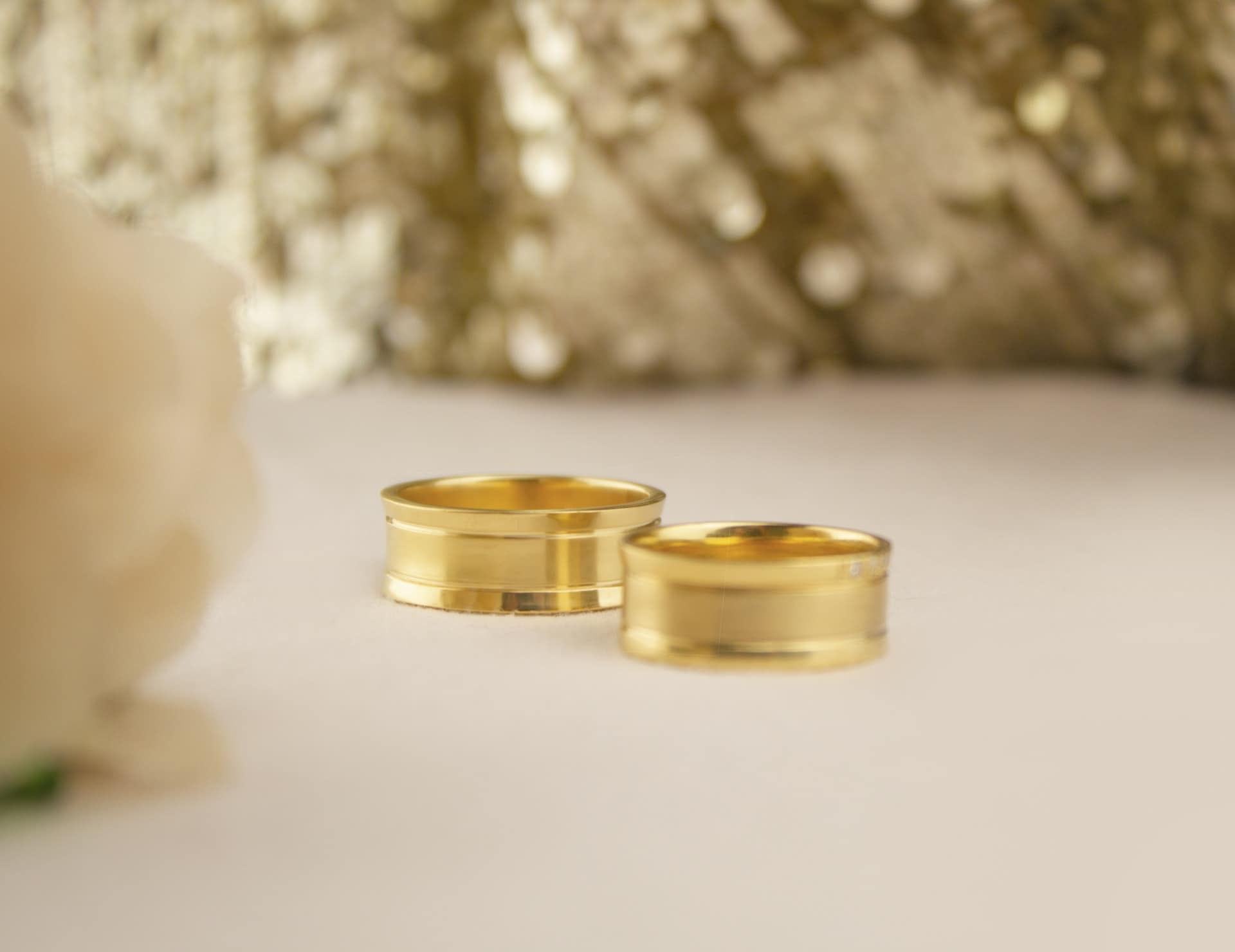
Table of Contents
Gold is one of the oldest metals that’s been used and highly valued by most human civilizations that stumbled upon it. By most reports, people have been digging up gold for about 6,000 years with some prominent examples being the Asosa region of Ethiopia and the Sakdrisi mine in Georgia. There are many that believe that people have known about gold even centuries or millennia before that.
All that, coupled with its rarity and the fact that gold has quite a few unique physical and chemical characteristics makes it both extremely valuable and somewhat easy to identify. However, there are several varieties of gold on the market and so it can get difficult to tell whether gold is real or not, just by looking at it.
Let’s take a look at nine different ways to test for real gold. While not all of these are foolproof, they will give you an indication of what to look out for.
Will the Bite Test Work?

First of all, no, the “bite test” we see on movies and TV is not a good idea. Theoretically, pure 24K gold would be soft enough to mark and bend with a bite, but
1. Most jewelry gold alloys aren’t 24 karats, and contain other metals that make it too hard to bend from a human’s bite. In fact, that’s why they are made into alloys with other metals – so that they won’t bend and get damaged that easily.
2. If it is indeed pure gold, you’ll damage the piece, which is probably the opposite of what you want.
So, if you can’t just nibble on your supposedly gold ring to test if it’s real, what else can you do? Below we’ve listed 9 easy ways how to know if gold is real.
How To Know If Gold Is Real
Most of the solutions below are quite easy and can be performed by anyone with standard household items. Some of the tests can involve you purposefully scratching the jewelry piece or dropping acid onto it, however, so it might be wise to try these last.
1. Inspect the jewelry piece for any markings and do some research.
The first thing to do with any jewelry piece before you start performing any actual tests on it is to check for any authenticity stamps, engravings, and markings on it. Any proper golden jewelry piece will have multiple hallmarks on it such as:
- Karat purity numbers (10K, 14K, 16K, 18K, etc.) are engraved somewhere on the piece, probably on the inside or on the back.
- Purity numbers in other measurement systems such as the Millesimal Fineness system (417, 585, 750, 958, and others).
- A manufacturer’s mark or seal.
- Markings for gold alternatives (such as gold under 10K, gold platings, gold fillings, etc.) – GP, GF, GE, GEP, HGP, HEG.
Hallmarks such as these and others can tell you what kind of metal you’ve got on your hands, exactly. If you see any hallmark that you don’t recognize, you can always do a little research online and find out what it means. This way, you’ll likely get all the information you need without having to bother with any of the tests below.
2. The wear and tear check-up.
If you’ve been wearing the jewelry piece for a while, you can just inspect it thoroughly for any wear and tear. If there is a bit of discoloration somewhere on the metal, then what you’ve got is likely not gold as gold doesn’t tarnish.
The reason we said “likely” above is that mid-to-low-karat gold such as 12K and 14K does have enough other metals in the alloy to tarnish a little bit. This is unlikely to happen in a short amount of time, however, and you’ll likely have to wear it for a while.
Plus, the discoloration won’t be nearly as significant as with fake gold. Again, note that 14K and 12K gold alloys are still very much considered “real gold” – anything over 10K is.
3. The skin check.
Another similar and very simple and harmless test you can always do is to check for any noticeable coloring or markings on your hands after wearing the jewelry piece for a bit.
Gold doesn’t tarnish, change color, or leave marks, so, if there is any coloring left on your skin, then what you’ve got isn’t pure gold.
If you don’t want to just wear the piece for a while, you can always just rub it on your skin a bit. If there are no markings whatsoever, this isn’t necessarily a guarantee that what you’ve got is gold, but the opposite would (almost) be a guarantee that it isn’t.
4. The vinegar test.
If you’re up to some actual testing, you can always take a few drops of vinegar in a pipette dropper to put a couple of vinegar drops on the jewelry piece. Let the liquid sit on the metal for 10 to 15 minutes and then wipe it off gently with a piece of cloth. If there is some discoloration, what you’ve got isn’t real gold. If the color has remained consistent and undamaged – the piece is indeed made out of gold.
Note that you’d probably want to do this test on the inside or on the back of the jewelry piece – somewhere that any color change won’t be noticeable. If you don’t care about the piece if it’s not gold, however, you can always just drop it in a vat of vinegar – if it’s made out of gold, it will be unharmed.
5. The water test.
A completely harmless test you can try if you don’t want to use any chemicals is to just fill a large pitcher with lukewarm tap water. Then, just drop the jewelry piece in it – whatever metal it’s made out of should be completely unharmed by standard tap water.
Instead of discoloration, what you should be looking for here is whether the piece sinks or floats. If it doesn’t sink, then it’s not gold. If it does sink, then it might be gold, but you’d probably want to perform a couple more tests.
6. The weight test.
A more in-depth weight test would involve you just measuring the volume of the metal piece and weighing it too. From there, you’d want to get another similarly sized piece that you know for a fact is made out of gold and measure it.
The purpose of all that is to see if the piece you’re testing is too light for its size. Real gold is quite a bit denser than most other metals. So, if the weight/volume ratio of the “supposed gold” you’re testing is lighter than the weight/volume ratio of a piece you know is made of gold, then the former is likely a fake (or, at least, a much lower karat alloy).
7. The magnet test.
An even simpler test would be to see if the metal you’re suspicious of is magnetic. Gold is not magnetic, so, if a magnet attracts your piece, then it’s not real gold.
A key point to note here would be that silver, copper, and palladium – the most common additions to proper jewelry gold alloys – also aren’t magnetic. So, even If your jewelry piece is 14K gold (and 10K silver, copper, and palladium) it still shouldn’t be magnetic.
8. The acid test.
Back in the realm of chemistry, you can try other acids in addition to vinegar to test the mettle of your metal. Nitric acid is a good thing to try here. If you don’t want to drop acid on a jewelry piece, you can rub the back of it onto a black stone to leave a bit of a mark on it. Then, just dribble a drop of the nitric acid on the mark and see if it dissolves – if it does, then the jewelry you have isn’t made out of gold.
You may have heard that aqua regia – a.k.a. nitrohydrochloric acid, a mix of 75% nitric acid and 25% hydrochloric acid – is the only acid that can dissolve gold. That’s absolutely true, so, naturally, you wouldn’t want to drop any of it on top of a jewelry piece you hope is made out of gold. However, you can repeat the above test and rub the back of the jewelry piece on a black stone to leave a tiny mark on it. Then, just drop some aqua regia on the mark and see what happens.
9. Just take it to a reputable jeweler.
The simplest, easiest, and most fool-proof test is to just take your jewelry piece for a second opinion at a reputable jeweler. The key word here is “reputable”, of course, as you don’t want to be lied to by two charlatans at the same time. If you find the right person, however, they’d be able to tell you everything there is to know about your jewelry piece.
Wrapping Up
With all of its unique properties, gold is quite easy to identify, especially if you have a bit of time on your hands. The problem with all of the above methods is that many of them are not very convenient to do while you’re in the shop.
Technically, you can go in with a pitcher of water and ask if you can drop a few rings in it to see if they’d sink but you’ll probably get a “No” on that request in most cases.
This is why it’s important to always shop from reputable retailers. It’s also why it’s wise to always make sure there is a return policy – this way, you can test the jewelry piece yourself or go to another jeweler for a second opinion before the return period is over.
Check our article comparing reputable retailers selling diamonds and gold online. These are tried and tested vendors who stand by their products and remain trustworthy.









